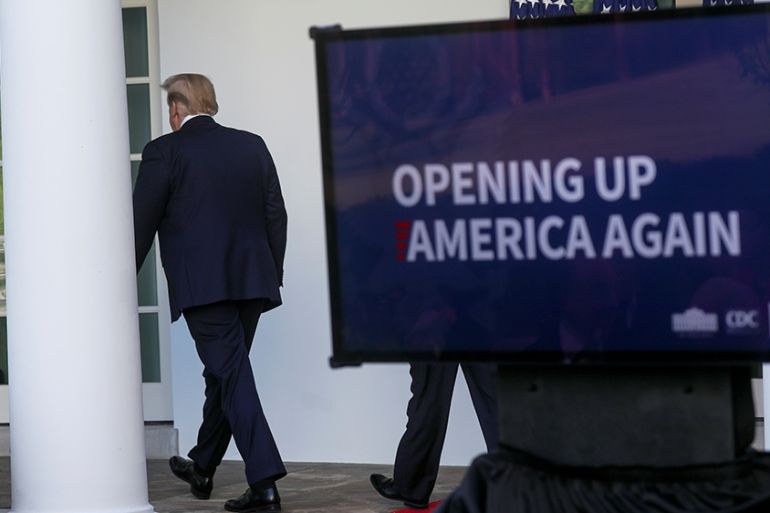Recession sign: US economy shrinks 4.8 percent in first quarter
The plunge in first-quarter US GDP will likely pale in comparison to second quarter damage from coronavirus lockdowns.

We knew the United States economy had likely taken a significant hit in the first three months of this year as coronavirus lockdowns started sweeping the nation in March. On Wednesday, government data showed just how bad the blow was.
US economic growth as measured by gross domestic product (GDP) contracted 4.8 percent on an annualised basis in the first quarter of this year, the Bureau of Economic Analysis (BEA) said on Wednesday. That is the sharpest decline since the height of the Great Recession, and marks an abrupt end to the longest economic expansion in the nation’s history.
Keep reading
list of 3 itemsOnce recession-proof, US trucking is squeezed by coronavirus
Recession or depression? What’s the difference?
The reading effectively confirms that the economy has entered a sharp recession.
“The decline in first-quarter GDP was, in part, due to the response to the spread of COVID-19, as governments issued “stay-at-home” orders in March. This led to rapid changes in demand, as businesses and schools switched to remote work or canceled operations, and consumers canceled, restricted, or redirected their spending,” the BEA said in its release.
Most of the major components that drive US economic activity contracted in the first quarter. Consumer spending, which accounts for roughly two-thirds of the country’s economic growth, showed its steepest drop since 1980.
Imports nosedived 15.3 percent – reflecting the falloff in demand domestically, while exports fell 8.7 percent as global demand also dried up in the wake of coronavirus containment measures.
Business investment fell 8.6 percent – the sharpest quarterly fall since the Great Recession.
As bad as the first quarter was, economists are expecting much worse for the current quarter.
“While the 4.8% annualized plunge in real GDP is the sharpest contraction since 2008, it will pale in comparison with the near-40% plunge in Q2,” US economists at Oxford Economics wrote in a note to clients on Wednesday.
Capital Economics chief US economist Paul Ashworth has a similarly dire outlook, writing in a note on Wednesday: “Even with some states now tentatively re-opening, we anticipate a 40% annualised decline in second-quarter GDP.”
The news could heap even more pressure on state and local governments to ease coronavirus lockdown restrictions to get the economy back up and running again.
The number could also provide fodder for critics of President Donald Trump’s handling of the coronavirus pandemic.
In January, Trump positioned his stewardship of the economy as a cornerstone of his re-election campaign, often boasting that he has created the “greatest economy” in the history of the country.
But report after report confirms that coronavirus lockdowns are wreaking tornado-like destruction on the economy and the financial lives of US citizens.
Some 26.6 million Americans filed for unemployment benefits in the five weeks ending April 18, with applications appearing to peak in late March.
But a survey released on Tuesday by the progressive think tank The Economic Policy Institute showed that millions of Americans who have lost their jobs during the pandemic have been unable to file for unemployment benefits as the systems around the US buckle under the sheer volume of new claims.
The wave of sudden joblessness and social distancing conspired to push retail sales off a cliff in March, plunging a record 8.7 percent. That is momentous because it indicates that the engine of the US economy – consumer spending – has taken a huge body blow.
And it could get worse. The Conference Board’s Consumer Confidence Index dropped significantly in April from March’s downwardly revised reading. And though the board’s Expectations Index – a gauge of how consumers feel about the short-term outlook for income, business and labour market conditions – registered a healthy improvement in April from the previous month – when it comes to personal fortunes, the reading indicated that consumers could be reluctant to reopen their wallets as the economy kicks back to life.
“Consumers were less optimistic about their financial prospects and this could have repercussions for spending as the recovery takes hold,”said Lynn Franco, the Senior Director of Economic Indicators at The Conference Board.
Manufacturing, a sector of the economy Trump has promised to revitalise, has also been slammed by lockdown measures with factory output in March falling to its lowest level since 1946.